| Columns Retired Columns & Blogs |
Chord Choral Blu CD transport & Choral DAC64 digital audio converter Measurements
Sidebar 3: Measurements
Footnote 1: A high-level tone at 11.025kHz, with the LSB toggled on and off at 229.6875Hz. Because both signal frequencies are exact integer fractions of the sample rate, the signal is free from quantizing distortion, and any spuriae appearing in the analog output of the device under test will be due to the latter's behavior.—John Atkinson
Chord's Choral Blu offers a surprisingly large number of output options for a CD transport. To examine what it did, I connected its data output to the digital input of the RME soundcard fitted to my PC and looked at the data in the digital domain using Adobe Audition and RME's DIGICheck program. Fig.1 shows the statistics of the Blu's output data while it was set to upsample those data to 88.2kHz and increase the word length to 24 bits. The test signal was 16-bit "digital black" on a test CD. DIGICheck indicates that bits 1–16 are indeed permanent zero, shown by the "0" on a blue background for each bit. But bits 17–24 are active and changing, indicated by the asterisk on a green background for each bit, with an RMS level of –98.1dB. The sample rate is indicated as "88.2kHz." Fig.2, derived by digital-domain FFT analysis of a 10-second sample using Adobe Audition, indicates that the spectrum of the signal in those eight LSBs is random noise, extending up to 44.1kHz, half the new sample rate, and with a slight rise in level at very low frequencies. I am confident in saying that this noise will not be audible, though it is possible that the downstream DAC might behave in a more linear manner with these bits active.

Fig.1 Chord Choral Blu, set to 88.2kHz output sample rate and 24-bit word length, bit statistics while playing back "digital black" from CD.
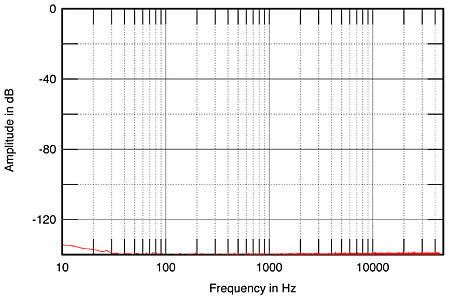
Fig.2 Chord Choral Blu, set to 88.2kHz and 24-bit word length, digital-domain spectrum, 10Hz–45kHz, of output data while playing back "digital black" (left channel blue, right channel red, 20dB/vertical div.).
The upsampling and increase in bit depth don't add information to the signal, as is shown in figs. 3 and 4. Fig.3 is a digital-domain spectral analysis of the 1kHz, 0dBFS test tone on the CBS Test CD. Some spurious tones can be seen; these are encoded on the disc but are all at or below –120dBFS. Fig.4 shows the spectrum of the same signal after it has been upsampled to 88.2kHz and 24 bits by the Choral Blu. Careful inspection reveals that, other than the introduction of the wideband random dither noted earlier, the spectrum is identical to that of fig.3.
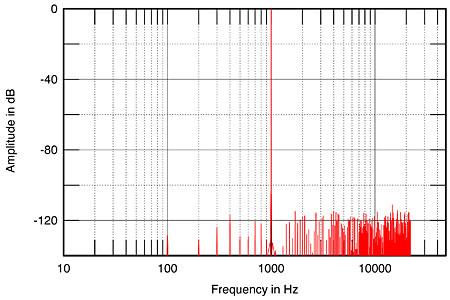
Fig.3 Chord Choral Blu, set to 44.1kHz and 16-bit word length, digital-domain spectrum, 10Hz–45kHz, of output data while playing back 1kHz at 0dBFS from the CBS Test CD (left channel blue, right channel red, 20dB/vertical div.).
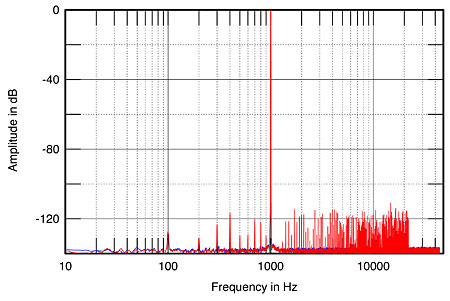
Fig.4 Chord Choral Blu, set to 88.2kHz and 24-bit word length, digital-domain spectrum, 10Hz–45kHz, of output data while playing back 1kHz at 0dBFS from the CBS Test CD (left channel blue, right channel red, 20dB/vertical div.).
The Blu's error correction was excellent, if not quite to the standard set by players that use DVD transport mechanisms. It offered slight glitches at the starts of tracks 31 and 32 on the Pierre Verany test CD, which respectively feature 1mm and 1.25mm gaps in the data spiral, but didn't mute momentarily on every revolution of the disc until the missing data reached 2mm in length. Unusually, the error flag in the output data word was not triggered when the player couldn't correct or conceal the missing data.
Turning to the Chord Choral DAC64, I reviewed two samples of an earlier version of this processor, serial numbers USD013 and USD015, in the July 2002 Stereophile, and my measurements reviewed some problems, particularly with the first sample. But as you will read, this new sample, serial number 9934, performed very much better, and in some ways approached the state of the art.
From its unbalanced jacks, the Choral DAC64's maximum output level at 1kHz was 3.086V, 3.8dB above the CD standard's 2V RMS. This doubled as expected from the balanced jacks. Both sets of outputs inverted absolute polarity, suggesting that the XLRs are wired with pin 3 hot rather than the usual pin 2. The DAC64's source impedance was 131 ohms balanced and 66.5 ohms unbalanced at low and midrange frequencies, these figures rising inconsequentially to 216 and 105 ohms, respectively.
The DAC64's frequency response rolled off very slightly at the top of the passband with both 44.1kHz and 96kHz data (fig.5, top pairs of traces). With pre-emphasized data sourced from the Blu transport, the response suffered a 0.9dB negative error in the mid treble, which will make those rare pre-emphasized CDs sound a little laidback (fig.5, bottom traces). The original DAC64 did not behave in this manner. Channel separation (not shown) was superb in the L–R direction, at >120dB below 4kHz, but 20dB or so worse in the other direction. This is still excellent, however.
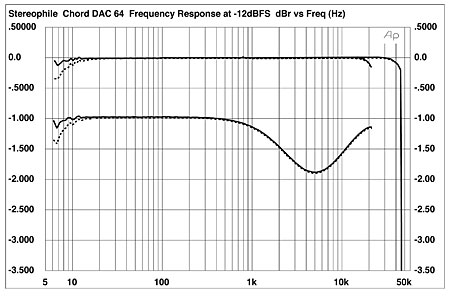
Fig.5 Chord Choral DAC64, frequency response at –12dBFS into 100k ohms at 44.1kHz without pre-emphasis (middle), with preemphasis at 44.1kHz (bottom), and at 96kHz (top) sample rates (right channel dashed, 0.5dB/vertical div.).
The 2002 samples of the DAC64 appeared to truncate 24-bit data when the RAM buffer was engaged, which to some extent rendered moot the enhanced resolution. But as revealed by fig.6, which shows 1/3-octave spectral analyses of the DAC64's output while it decoded 16-bit data representing a dithered 1kHz tone at –90dBFS and 24-bit data representing dithered 1kHz tones at –90dBFS and –120dBFS, with the RAM buffer set to its long setting, the increase in bit depth results in an 18dB lowering of the noise floor, suggesting a true resolution of close to 19 bits, which is excellent DAC performance. These traces are free from spuriae at power-supply–related frequencies, even with 24-bit data, but a trace of second-harmonic distortion can be seen on the hi-rez analyses, this unmasked by the reduction of the noise. Extending the measurement bandwidth to 20kHz and feeding the DAC64 16-bit data representing a –1LSB DC offset (not shown) revealed a gentle rise in the noise above the audioband, with slight but still very-low-level peaks at 44.1kHz and 88.2kHz in the left channel. Again, and very commendably, no power-supply noise could be seen, and the noise floor overall is around 5dB lower than that of the 2002 samples.
Other than the tone at 1kHz, the top traces in fig.6 really show only the contribution of the recorded 16-bit dither noise. Similarly with fig.7, the actual DAC linearity error is less than the contribution of the dither. Repeating this test with 24-bit data resulted in negligible linearity error down to the –120dBFS limit of the analysis. As a result of the superb linearity and very low noise, the DAC64's reproduction of undithered 16-bit data (fig.8) and 24-bit data (fig.9) representing a 1kHz tone at exactly –90.31dBFS were essentially perfect. In particular, the Gibbs Phenomenon "ringing" with the lower-rez data (fig.9) is clearly defined, as are the three DC voltage levels.
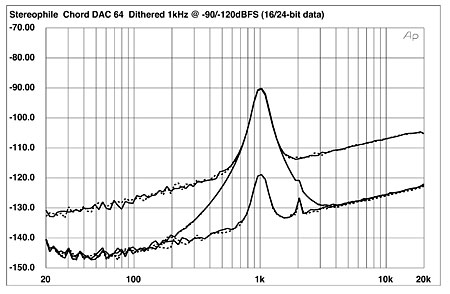
Fig.6 Chord Choral DAC64, 1/3-octave spectrum with noise and spuriae of dithered 1kHz tone at –90dBFS, 16-bit data (top), 24-bit data (middle), and of dithered 1kHz tone at –120dBFS (bottom). (Right channel dashed.)
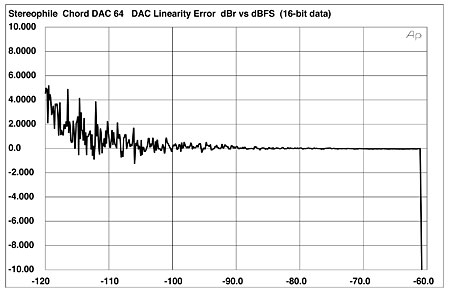
Fig.7 Chord Choral DAC64, right-channel departure from linearity, 16-bit data (2dB/vertical div.).
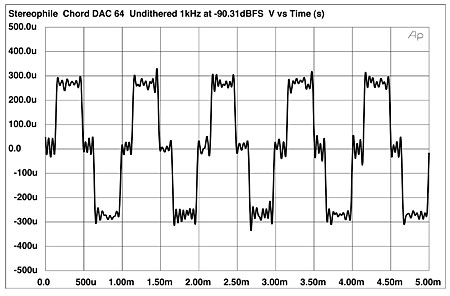
Fig.8 Chord Choral DAC64, waveform of undithered 1kHz sinewave at –90.31dBFS, 16-bit data.
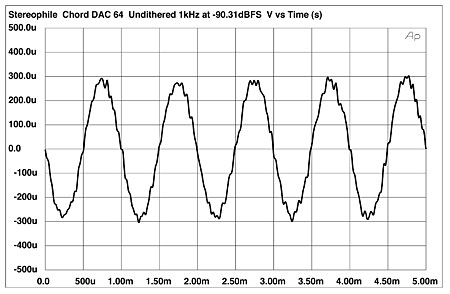
Fig.9 Chord Choral DAC64, waveform of undithered 1kHz sinewave at –90.31dBFS, 24-bit data.
The DAC64 had very low levels of harmonic (fig.10) and intermodulation (fig.11) distortion, even into low impedances (both graphs were taken with 24-bit data). However, the output clipped at full scale into the admittedly punishing 600 ohm load.
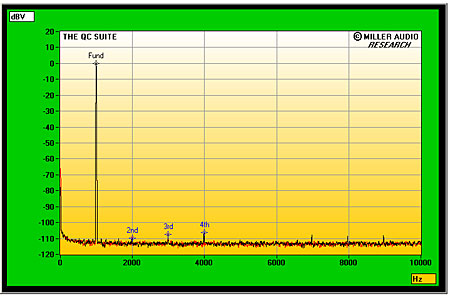
Fig.10 Chord Choral DAC64, spectrum of 1kHz sinewave at 0dBFS into 8k ohms, unbalanced (linear frequency scale).
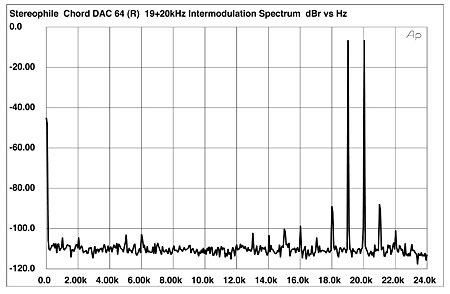
Fig.11 Chord Choral DAC64, HF intermodulation spectrum, 19+20kHz at 0dBFS peak into 100k ohms, balanced (linear frequency scale).
Finally, I examined the DAC64's rejection of word-clock jitter using the Miller Audio Research Analyzer. Even without the RAM buffer engaged, the jitter level was both very low, and lower than the better-performing second sample I measured in 2002. Fed a 16-bit version of the analytic signal1 from my PC via a TosLink connection, without the RAM buffer in-circuit, the jitter level of the 2007 sample was 326 picoseconds peak–peak compared with 587ps p–p for the second 2002 sample. And while there was still a rise in random jitter on either side of the spectral peak representing the high-level tone at one quarter the sample rate (fig.12, grayed-out trace), this rise is significantly lower than with the earlier sample.
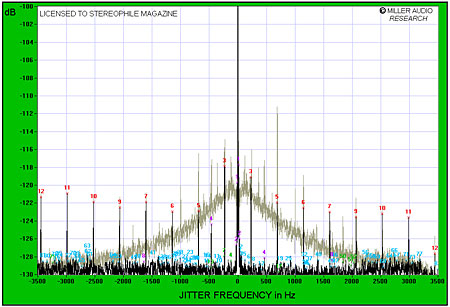
Fig.12 Chord Choral DAC64, high-resolution jitter spectrum of analog output signal (11.025kHz at –6dBFS, sampled at 44.1kHz with LSB toggled at 229Hz), 16-bit CD data, upsampled to 176.4kHz and 24-bit word length, with long RAM buffer. Grayed-out trace is the same data at 44.1kHz and 16 bits, without any RAM buffering. Center frequency of trace, 11.025kHz; frequency range, ±3.5kHz.
Still using the PC-TosLink source, switching in the DAC64's RAM buffer set to its shorter size reduced the jitter to a superbly low 147ps. Peculiarly, the longer RAM buffer setting increased this slightly, to a still negligible 154ps. Changing to the Blu transport as a source, the TosLink connection without upsampling or word-length enhancement but with the long RAM buffer engaged gave 184ps of word-clock jitter, while going for broke by upsampling to 176.4kHz and using a dual S/PDIF connection gave just 156ps of jitter. The spectrum of the DAC64's analog output in the final condition is shown as the black trace in fig.12. With the exception of the sideband pair at ±229.69Hz (red "3"), the data-related sidebands (red numeric markers) are close to the test signal's residual level, and the rise in random low-frequency jitter has been completely eliminated. This is about as good as it gets, using my current test gear.
Unlike the 2002 samples of the DAC64, and putting to one side the deemphasis error, which will not affect many CDs, this sample offered superb performance in every aspect of performance. Wow!—John Atkinson
Footnote 1: A high-level tone at 11.025kHz, with the LSB toggled on and off at 229.6875Hz. Because both signal frequencies are exact integer fractions of the sample rate, the signal is free from quantizing distortion, and any spuriae appearing in the analog output of the device under test will be due to the latter's behavior.—John Atkinson
- Log in or register to post comments



































